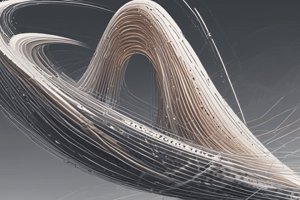Podcast
Questions and Answers
Displacement describes a change in ______.
Displacement describes a change in ______.
position
Kinematics focuses on describing the motion of objects without delving into the causes of that ______.
Kinematics focuses on describing the motion of objects without delving into the causes of that ______.
motion
Velocity is the rate at which an object changes its ______.
Velocity is the rate at which an object changes its ______.
position
Acceleration is the rate at which an object's velocity ______.
Acceleration is the rate at which an object's velocity ______.
Velocity is the derivative of displacement with respect to ______.
Velocity is the derivative of displacement with respect to ______.
Acceleration is the derivative of velocity with respect to ______.
Acceleration is the derivative of velocity with respect to ______.
In astronomy, kinematics helps us understand the motion of celestial bodies like ______, stars, and galaxies
In astronomy, kinematics helps us understand the motion of celestial bodies like ______, stars, and galaxies
Kinematics plays an integral role in many aspects of ______
Kinematics plays an integral role in many aspects of ______
In engineering, kinematics helps design and analyze mechanisms such as robots, machinery, and ______
In engineering, kinematics helps design and analyze mechanisms such as robots, machinery, and ______
In everyday life, kinematics can be seen at work in transport systems like trains, buses, and ______
In everyday life, kinematics can be seen at work in transport systems like trains, buses, and ______
As we advance into new fields like space exploration, quantum computing, and nanotechnology, kinematics will continue to be a vital tool for understanding the motion of objects in these emerging ______
As we advance into new fields like space exploration, quantum computing, and nanotechnology, kinematics will continue to be a vital tool for understanding the motion of objects in these emerging ______
By diving deeper into kinematics and its applications, you'll be able to develop a richer appreciation of the physics of motion and its role in our ______ lives
By diving deeper into kinematics and its applications, you'll be able to develop a richer appreciation of the physics of motion and its role in our ______ lives
Flashcards are hidden until you start studying
Study Notes
Kinematics in Physics: The Study of Motion
Kinematics, a fundamental branch of physics, focuses on describing the motion of objects without delving into the causes of that motion. This field finds its roots in the principles of displacement, velocity, acceleration, and time. By exploring these concepts, we can deepen our understanding of how objects move and interact in the world around us.
Displacement
Displacement describes a change in position. It is a vector quantity, meaning that it has both magnitude and direction. Displacement is represented by the symbol (\Delta\vec{r}), where (\Delta) denotes the change and (\vec{r}) represents position.
Velocity
Velocity, denoted as (\vec{v}), is the rate at which an object changes its position. It is the derivative of displacement with respect to time:
[ \vec{v} = \frac{d\vec{r}}{dt} ]
Velocity has both magnitude and direction, making it a vector quantity.
Acceleration
Acceleration, denoted as (\vec{a}), is the rate at which an object's velocity changes. It is the derivative of velocity with respect to time:
[ \vec{a} = \frac{d\vec{v}}{dt} ]
Acceleration can be caused by changes in velocity or changes in direction, and it is also a vector quantity.
Time
Time, represented by (t), is a scalar quantity that measures the duration of motion. Time is a fundamental aspect of kinematics, as it is essential for describing the behavior of objects in motion.
Applications of Kinematics
Kinematics plays an integral role in many aspects of physics. For example, in astronomy, kinematics helps us understand the motion of celestial bodies like planets, stars, and galaxies. In engineering, kinematics helps design and analyze mechanisms such as robots, machinery, and vehicles. In everyday life, kinematics can be seen at work in transport systems like trains, buses, and cars, as well as sports like swimming, running, and cycling.
The Future of Kinematics
As we advance into new fields like space exploration, quantum computing, and nanotechnology, kinematics will continue to be a vital tool for understanding the motion of objects in these emerging domains. With the discovery of new motion-related phenomena, kinematics will evolve and adapt to explore the fascinating world of motion in ways we could scarcely imagine today.
This article is intended to introduce you to the foundational principles of kinematics, helping you understand how we describe the motion of objects in the world around us. By diving deeper into kinematics and its applications, you'll be able to develop a richer appreciation of the physics of motion and its role in our daily lives.
Studying That Suits You
Use AI to generate personalized quizzes and flashcards to suit your learning preferences.




